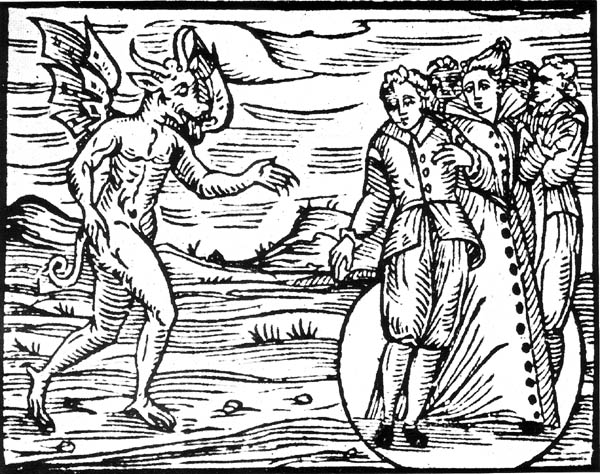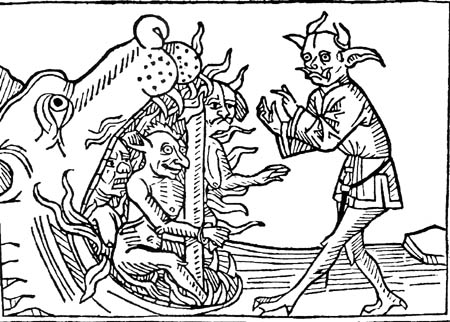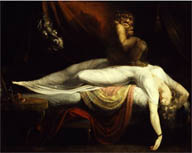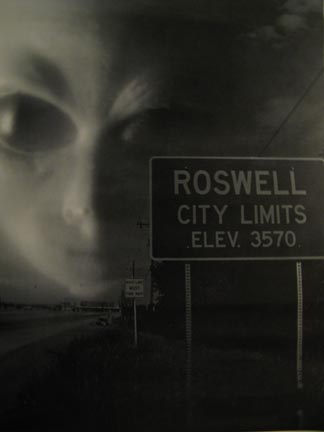|
DON'T FORGET TO CHECK HAMLET AND THE DAEMONS by RAYMOND NIGHAN: CLICK HERE.
|
|||||||
 |
|||||||
 |
|||||||
|
The Devil Forces a Pact on Those Have Made Him Appear.
|
|||||||
|
The Mouth of Hell
|
|||||||
Return to Table of Contents for Shakespeare
Return to Henry James (Gothic Page)
RETURN TO CHAPTER III OF HAMLET AND THE DAEMONS
RETURN TO RENAISSANCE PSYCHOLOGY
RENAISSANCE THEORIES OF GHOSTS AND DEMONS
(with a Renaissance to pop culture parallel)
NOTE: As with other sections of this material, you must locate the primary source if you wish to include quoted material in a paper. This outline offers an historical perspective, beginning with Medieval views. Some suggested readings include:
DeGivry, E. Sorcery, Magic and Alchemy. New York: Mallard Press, 1991
Greenblatt, S. Hamlet in Purgatory. Princeton: Princeton University Press, 2001
Prosser, E. Hamlet and Revenge. Stanford: Stanford University Press, 1971.
Summers, M. (ed.) The Malleus Maleficarum (of Heinrich Kramer and James Sprenger)
New York: Dover, 1971.
and...
|
DON'T FORGET TO CHECK HAMLET AND THE DAEMONS by RAYMOND NIGHAN: CLICK HERE.
|
|||||||
 |
|||||||
 |
|||||||
|
The Devil Forces a Pact on Those Have Made Him Appear.
|
|||||||
|
The Mouth of Hell
|
|||||||
ST. AUGUSTINE: (THE CITY OF GOD)
1. The devil may transform himself into an angel of light
2. The devil--with God's permission may transform a "man's phantasm into a bodily shape.
3. The devil can do nothing without God's permission.
ST. THOMAS AQUINAS: (SUMMA)
1. The dead may appear to the living only with God's permission.
2. Demons may punish as part of God's plan.
3. Demons may reveal the truth to men, but their purpose is to punish and damn a soul.
4. Purgatory exists with the pain (fire) of hell, except it is temporary.
LEWES LAVATER: (OF GHOSTS AND SPIRITS WALKING BY NIGHT)
1. Men who are mad / melancholy see apparitions that are not there.
2. What appears will either be a good or evil angel.
3. Spirits that are good appear to comfort the living.
4. A good spirit will ask that masses be said for its comfort.
5. Spirits sometimes playfully or horribly appear to miners.
6. Spirits may appear in the shape of a man recently killed in a in a pleasing or horrible form.
7. Spirits are allowed to come from hell only for a time; there is is no purgatory.
8. There are four tests which the church uses to determine if a spirit is good or evil:
a. good spirits terrify initially, but ultimately comfort.
b. good spirits associate with light; evil with darkness
c. evil spirits command that which is counter to the church.
d. good spirits profess humility; evil spirits will threaten and use vile language
9. Evil spirits will often speak the truth.
10. Spirits of men killed without benefit of sacrament will return to beg for it.
11. It is best to avoid all contact with spirits.
THOMAS NASH: (THE TERRORS OF THE NIGHT)
1. To fool men, a spirit will often return in the guise of one's parents.
JAMES I: (DAEMONOLOGIE)
1. A spirit will return to one who seeks revenge, is ignorant, is evil or who hates God.
2. An evil spirit finds it easy to work on a melancholic mind.
3. A spirit may cause madness, a humor imbalance, the evil to suffer or the good to be tested
SCOT: (THE DISCOVERIE OF WITCHCRAFT)
1. Devils will encourage us to follow our base inclinations (appetites)
2. Those who are proud, angry, or lustful will fall to evil spirits.

BURTON: (ANATOMY OF MELANCHOLIE)
1. As a result of original sin, all men are prone to melancholy.
2. The devil will often cause violent separation between children and parents.
3. Jealously can turn a man to destructive passion.
4. The devil can cause madness by first affecting fantasy; he can terrify the mind.
5. In melancholy individuals, fantasy is especially strong, made worse if terrified by something objective.

SPECIAL NOTE ON REVENGE:
In the Renaissance revenge was forbidden as belonging to God, but with an important qualification. Private revenge was always wrong--if the individual were to retaliate for a wrong, but public revenge was considered allowable in which the agent acted as God's minister or representative to right a wrong for the public good.
SHAKESPEAREAN TRAGEDY AND EVIL:
Evil in a Shakespeare play often emerges from obscure causes but grows with powerful effect, destroying much of the good in the process. In Hamlet, the title character offers one possibility that can serve as a prototype for the other tragedies:
So oft in chances in particular men
That for some vicious mole of nature in them,
As in their birth--wherein they are not guilty,
Since nature cannot choose his origin--
By their overgrowth of some complexion
Oft breaking down the pales and forts of reason,
Or by some habit that too much overleavens
The form of plausive manners, that these men,
Carrying, I say, the stamp of one defect,
Being nature's livery or fortune's star,
Their virtues else--be they as pure as grace,
As infinite as man may undergo--
Shall in the general censure take corruption
From that particular fault.
Macbeth, the title character in his play, offers another possibility. When confronted with agents of the supernatural, the witches who foretell Macbeth's future, are challenged by Macbeth's friend, Banquo who says...
If you can look into the seeds of time,
And say which grain will grow, and which will not...
This view of evil, unlike Hamlet's, suggests evil having an external dimension, one based on the following Medieval and Renaissance theories of creation:
God's mind has in it from all eternity everything that will be created in time. These may be called ideas of forms of X (trees, stars, people etc.). God creates matter called prime or first matter which is created by in a disorganized fashion. Existing as part of this matter are the "germs" or SEEDS of that which is to be created. These seeds correspond to the forms in God's mind, and creation is the act of uniting form and matter.
Notes:
God creates continuously from within
He already has created within prime matter the germ of all possible beings
What is created happens (to us) over time and depends on: nature (God's will), meaning what God allows demons and their agents (witches) to do/not do...
Analogy: a pregnant mother : unborn child :: world pregnant : unborn ideas
Often, evil paradoxically comes form the good, and good from evil, so Banquo asks if the devil can speak true! The doctrine, taken from a historical event involving equivocation, suggests that demons and the witches as their agents will appear to tell the truth, but for the purpose of entrapment or damning a soul.
The Renaissance and pop culture:
Look at these photos comparatively:
 |
What would Elsinore and Roswell, 1947 have in common? Is there an archeytpe, therefore common to both cultures, present? What apparently do we, in any age, have a need to validate?
|
 |
|||
RENAISSANCE HISTORY, PHILOSOPHY AND COSMOLOGY, PSYCHOLOGY [BURTON] AND SHAKESPEARE CURRICULUM LINKS